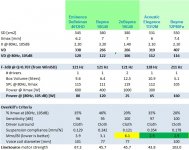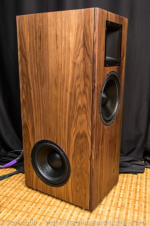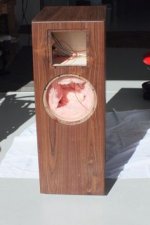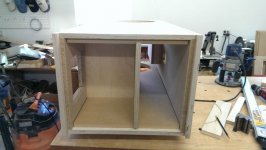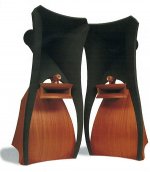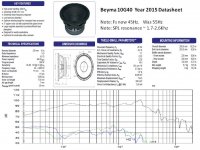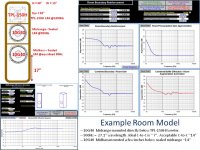So I'm progressing along my active 4-way design. Thanks to all who've been helping!
It's time to decide between my midbass finalists: Beyma 10G40 and Eminence 4012HO. They basically look the same on paper, with the 10G40 being much easier to source here, but being noted as "optimized for small vented enclosures" as a woofer. Hence this thread. How much should I trust my calculations?
I'm looking for tight, powerful midbass (80 to 500Hz). Sealed box. My subs are capable of 105dB at 80Hz, so this is the reference for the midbass.
I've looked into many midbass drivers (Beyma 12P80Nd, 12P80Fe, 12LX60V2, 12P1000Nd, SM-212, 12MI100, 10MI100, 10MW/Nd, Acoustic Elegance TD10M and TD12M, 18 Sound 10NMB420, several ScanSpeak, Seas, McCauley) and narrowed it down to these two. I think I'm done looking into alternatives.
From modelling in UniBox both drivers look pretty much the same:
I'm attaching a summary of my table, including the TD12M and 12P80Fe, that also looked good but were eventually discarded.
BTW, I plan to use two drivers per side, in parallel, driven by a Hypex UcD (thinking an NCore probably sounds the same in this frequency range).
Thank you!
It's time to decide between my midbass finalists: Beyma 10G40 and Eminence 4012HO. They basically look the same on paper, with the 10G40 being much easier to source here, but being noted as "optimized for small vented enclosures" as a woofer. Hence this thread. How much should I trust my calculations?
I'm looking for tight, powerful midbass (80 to 500Hz). Sealed box. My subs are capable of 105dB at 80Hz, so this is the reference for the midbass.
I've looked into many midbass drivers (Beyma 12P80Nd, 12P80Fe, 12LX60V2, 12P1000Nd, SM-212, 12MI100, 10MI100, 10MW/Nd, Acoustic Elegance TD10M and TD12M, 18 Sound 10NMB420, several ScanSpeak, Seas, McCauley) and narrowed it down to these two. I think I'm done looking into alternatives.
From modelling in UniBox both drivers look pretty much the same:
- At 80Hz and 105dB, both have the same Vd. Moving "enough air" is a goal, and while I initially assumed a 12" would move more than a 10", same Vd suggests they both move the same amount. Correct?
- In sealed boxes with Qtc=0.707, both have F3=121Hz
- Sensitivity is 95 vs 96dB. The same, for practical purposes.
- 10G40 would need 120W to get to 105dB at 80Hz, while the 4012HO would need 80W. I'm thinking a Hypex would take care of either one.
- Price is the same.
I'm attaching a summary of my table, including the TD12M and 12P80Fe, that also looked good but were eventually discarded.
BTW, I plan to use two drivers per side, in parallel, driven by a Hypex UcD (thinking an NCore probably sounds the same in this frequency range).
Thank you!
Attachments
Design goal: 80Hz - 400Hz in a sealed alignment.
A speaker + box_alignment that naturally meets the 80Hz - 400Hz design goal and uses equalization mainly for room effects will normally have better sound than a speaker+box which needs extensive equalization just to be flat over the main BW.
If a larger volume box is acceptable....many high efficiency speakers use a 80Hz 15" midbass:
The 97.5db/watt Lambda TD15M in a 3cuft sealed box has an F3 of 80Hz.
The 96.5db/watt Faital 15FH530 in a 1.6cuft sealed box has an F3 of 83Hz.
The 95db/watt Beyma 15LX60v2 in a 2.5cuft sealed box has an F3 of 71Hz.
The 98db/watt Beyma 15MI100 in a 1.9cuft sealed box has an F3 of 95Hz.
You might get some construction ideas from this TPL-150H build... CLD panels ... MDF+softglue+BirchPly ... fiberglass stuffing
Expert Engineers... Excellent Reviews... 12" midbass
The 96db/watt Faital 12FH530 in a 0.45cuft sealed box has an F3 of 129Hz. used in Geeks BMF. Two side mounted counter-force 12" woofers near floor.
https://www.pinterest.com/localhifishop/tweek-geeks-bmf-speaker-in-the-making/
A speaker + box_alignment that naturally meets the 80Hz - 400Hz design goal and uses equalization mainly for room effects will normally have better sound than a speaker+box which needs extensive equalization just to be flat over the main BW.
If a larger volume box is acceptable....many high efficiency speakers use a 80Hz 15" midbass:
The 97.5db/watt Lambda TD15M in a 3cuft sealed box has an F3 of 80Hz.
The 96.5db/watt Faital 15FH530 in a 1.6cuft sealed box has an F3 of 83Hz.
The 95db/watt Beyma 15LX60v2 in a 2.5cuft sealed box has an F3 of 71Hz.
The 98db/watt Beyma 15MI100 in a 1.9cuft sealed box has an F3 of 95Hz.
You might get some construction ideas from this TPL-150H build... CLD panels ... MDF+softglue+BirchPly ... fiberglass stuffing
Expert Engineers... Excellent Reviews... 12" midbass
The 96db/watt Faital 12FH530 in a 0.45cuft sealed box has an F3 of 129Hz. used in Geeks BMF. Two side mounted counter-force 12" woofers near floor.
https://www.pinterest.com/localhifishop/tweek-geeks-bmf-speaker-in-the-making/
Attachments
Design goal: 80Hz - 400Hz in a sealed alignment.
A speaker + box_alignment that naturally meets the 80Hz - 400Hz design goal and uses equalization mainly for room effects will normally have better sound than a speaker+box which needs extensive equalization just to be flat over the main BW.
Hey LineSource. Thanks for joining.
I certainly agree with that statement. Please note, though, in my intended application there is no boosting applied in the 80-100Hz, but rather the necessary trimming applied above 80Hz to keep the response at the target level. So as long as the box/driver can deliver enough SPL at 80hz I think I should be OK.
If a larger volume box is acceptable....many high efficiency speakers use a 80Hz 15" midbass:
The 97.5db/watt Lambda TD15M in a 3cuft sealed box has an F3 of 80Hz.
The 96.5db/watt Faital 15FH530 in a 1.6cuft sealed box has an F3 of 83Hz.
The 95db/watt Beyma 15LX60v2 in a 2.5cuft sealed box has an F3 of 71Hz.
The 98db/watt Beyma 15MI100 in a 1.9cuft sealed box has an F3 of 95Hz.
Man, you are perseverant!
My subwoofers are 12-inchers. Frankly, I can't make sense of midbasses larger than my subwoofers. Plus I suspect WAF will start becoming an issue at 15".
"larger" is in the eye of the beholder, though. 14" wide baffle is acceptable, I think. So either 10" or 12" midbass drivers. Looking at the 12" versions of what you propose:
- TD12M: extremely long lead times, some reports about quality variations over time (definitely not acceptable for me being so far away), and frankly the advantages of this driver seem to show up higher in the frequency range.
- 12LX60V2: more of a woofer than a midbass. Very high Mms/Bl of 5.2 vs my finalist drivers at 3.9 & 3.1. I looked seriously into these, though.
- 12MI100: very nice Mms/Bl of 2.1, but F3 of 203Hz for a sealed box with Qtc=0.707...is significantly worse than my finalists at 121Hz for the exact same reasons you gave in your first paragraph. Plus it needed to get close to Xmax to deliver 105dB at 80Hz.
You might get some construction ideas from this TPL-150H build... CLD panels ... MDF+softglue+BirchPly ... fiberglass stuffing
Expert Engineers... Excellent Reviews... 12" midbass
The 96db/watt Faital 12FH530 in a 0.45cuft sealed box has an F3 of 129Hz. used in Geeks BMF. Two side mounted counter-force 12" woofers near floor.
https://www.pinterest.com/localhifishop/tweek-geeks-bmf-speaker-in-the-making/
Thanks for the link. I can get some ideas for sure. I'm studying Troels' ATS4 at the moment. It's a different speaker, but also taking ideas from there.
Interestingly, Geeks BMF chose those 12" Faitals that have the same F3 as the 10" Beymas 10G40 I'm choosing (actually the 10G40 have 121Hz). Plus I plan to use two 10G40 per side...probably a bit of overkill there.
FWIW, my current design calls for 14" wide baffle, so baffle step should be around 325Hz which is well within the midbass range. I also plan to have 45° beveled edges about 2" long to diffuse the effect of baffle step.
How far from the floor should I place each midbass driver?
How far from the floor should I place each midbass driver?
Ideally, you want the C-to-C distance between the mid and midbass to be less than 1/4 the wavelength of the crossover frequency. Running a baffle simulator will illustrate how floor-bounce + wall gain mixes with different woofer heights. Start sim with midbass center 12" - 16" above ground.
----Baffle Edge Diffraction Simulator By Jeff Bagby Version 1.20----
Over the years Beyma has made several changes to the 10G40 without adding a version number. Beyma has the latest 2015 datasheet. As long as you can purchase a "matched pair" you should have a successful build since sealed boxes with slightly larger than spec volume are very forgiving on T/S.
Example shows a large enough Fs difference to suggest T/S measurements before you build.
2013... Old Fs = 45Hz
2015... New Fs =55Hz with about 91db @2.83V sensitivity, and cone break-up between 1.6-2.5Khz.
------
You caught me trying to convince you into building a pair of my favorite horn speakers.
Attachments
Ideally, you want the C-to-C distance between the mid and midbass to be less than 1/4 the wavelength of the crossover frequency. Running a baffle simulator will illustrate how floor-bounce + wall gain mixes with different woofer heights. Start sim with midbass center 12" - 16" above ground.
----Baffle Edge Diffraction Simulator By Jeff Bagby Version 1.20----
Over the years Beyma has made several changes to the 10G40 without adding a version number. Beyma has the latest 2015 datasheet. As long as you can purchase a "matched pair" you should have a successful build since sealed boxes with slightly larger than spec volume are very forgiving on T/S.
Example shows a large enough Fs difference to suggest T/S measurements before you build.
2013... Old Fs = 45Hz
2015... New Fs =55Hz with about 91db @2.83V sensitivity, and cone break-up between 1.6-2.5Khz.
------
You caught me trying to convince you into building a pair of my favorite horn speakers.
Those are actually art-looking speakers and might work! How tall are they?
Assuming a crossover frequency of 2500Hz, then that wavelength is 13.7cm (5.4"), hence midbass to midrange c-to-c needs to be less than 3.4cm. That can't be accomplished with 10" (25cm) drivers. What's the implication of not meeting this condition?
I will play around with the baffle step simulator tonite. Thanks for the tip!
Also thank you for pointing out the differences in the 10G40 specs over time. How can I measure T/S parameters at home though?
Room Model
-- 10G40 Midrange mounted directly below TPL-150H tweeter. ~1800Hz LR4
-- 500Hz = 27” wavelength . Ideal C-to-C is ~ 7”. Acceptable C-to-C ~14”
-- 10G40 Midbass mounted a few inches below sealed midrange ~14” C-to-C
You already know my story. If you can accept a 17" wide cabinet, a 15" woofer offers greater usage flexibility, plus F3 <80Hz without equalization, plus efficiency to cover baffle step.
The 96.5db/watt Faital 15FH530 in a 1.6cuft sealed box has an F3 of 83Hz.
The 95db/watt Beyma 15LX60v2 in a 2.5cuft sealed box has an F3 of 71Hz.
Only Agentina 12" in my spreadsheet---- Keep looking
The 96db/watt 12" Eminence Deltalite 2512 has F3=85Hz in 2cuft sealed box.
-------------
There are several good tutorials on how to measure T/S parameters. A few coins are often used for a known mass.
Download free sine sweep program + DVM + a couple resistors + small(20-50gram) weight + basic math.
With T/S parameters you can probably build a 90% perfect cabinet, and work on the crossover as time permits.
Measuring Loudspeaker Driver Parameters
T-S Parameter Calculator
SB Acoustics :: Technical Notes
-- 10G40 Midrange mounted directly below TPL-150H tweeter. ~1800Hz LR4
-- 500Hz = 27” wavelength . Ideal C-to-C is ~ 7”. Acceptable C-to-C ~14”
-- 10G40 Midbass mounted a few inches below sealed midrange ~14” C-to-C
You already know my story. If you can accept a 17" wide cabinet, a 15" woofer offers greater usage flexibility, plus F3 <80Hz without equalization, plus efficiency to cover baffle step.
The 96.5db/watt Faital 15FH530 in a 1.6cuft sealed box has an F3 of 83Hz.
The 95db/watt Beyma 15LX60v2 in a 2.5cuft sealed box has an F3 of 71Hz.
Only Agentina 12" in my spreadsheet---- Keep looking
The 96db/watt 12" Eminence Deltalite 2512 has F3=85Hz in 2cuft sealed box.
-------------
There are several good tutorials on how to measure T/S parameters. A few coins are often used for a known mass.
Download free sine sweep program + DVM + a couple resistors + small(20-50gram) weight + basic math.
With T/S parameters you can probably build a 90% perfect cabinet, and work on the crossover as time permits.
Measuring Loudspeaker Driver Parameters
T-S Parameter Calculator
SB Acoustics :: Technical Notes
Attachments
Room Model
-- 10G40 Midrange mounted directly below TPL-150H tweeter. ~1800Hz LR4
-- 500Hz = 27” wavelength . Ideal C-to-C is ~ 7”. Acceptable C-to-C ~14”
-- 10G40 Midbass mounted a few inches below sealed midrange ~14” C-to-C
You already know my story. If you can accept a 17" wide cabinet, a 15" woofer offers greater usage flexibility, plus F3 <80Hz without equalization, plus efficiency to cover baffle step.
The 96.5db/watt Faital 15FH530 in a 1.6cuft sealed box has an F3 of 83Hz.
The 95db/watt Beyma 15LX60v2 in a 2.5cuft sealed box has an F3 of 71Hz.
Only Agentina 12" in my spreadsheet---- Keep looking
The 96db/watt 12" Eminence Deltalite 2512 has F3=85Hz in 2cuft sealed box.
-------------
There are several good tutorials on how to measure T/S parameters. A few coins are often used for a known mass.
Download free sine sweep program + DVM + a couple resistors + small(20-50gram) weight + basic math.
With T/S parameters you can probably build a 90% perfect cabinet, and work on the crossover as time permits.
Measuring Loudspeaker Driver Parameters
T-S Parameter Calculator
SB Acoustics :: Technical Notes
Hello LineSource.
Yes, I know you recommend a 15" for midbass. I'm going to try and get good results with the 10G40, though, or otherwise the Eminence 4012HO.
The Jeff Bagby simulator is good. Thanks for the tip! My plan is to use two 10G40 for the midbass, but I can't find a way to model two drivers there. Am I missing something?
From simulating the top 10" midbass driver I see a significant dip (9 dB or so) in the combined baffle step + boundary reinforcement + presurization chart (the one in red at the bottom right). I also see another significant dip, although at a different frequency point, with the lower midbass unit. Of course I can't add both linearly, but I'm taking away it will be a good idea to have both drivers there playing together. Before this I was wondering if I was overdoing it with two drivers there. Seems I will need the extra SPL!
Thank you!
- Status
- This old topic is closed. If you want to reopen this topic, contact a moderator using the "Report Post" button.
- Home
- Loudspeakers
- Multi-Way
- Beyma 10G40 in SEALED box for 80-500Hz? Or Eminence 4012HO?
